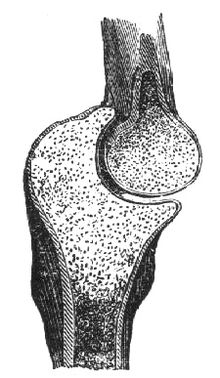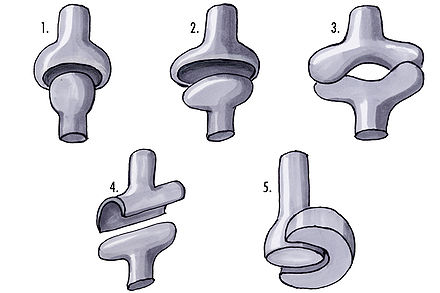Joint
![]()
This page is discussed in the sense of the guidelines for term clarifications on the discussion page of the wiki project Term clarification pages. Help to correct the deficiencies and participate in the discussion! Notes for revision: style sheet and FAQ. +
![]()
This article describes the joint in anatomy. For joints in engineering, see joint (engineering); in linguistics, see syllabic joint.
A joint (Latin articulatio, Ancient Greek ἄρθρον árthron) is, from an anatomical point of view, a movable connection of two or more bones.
If these bones fuse, this is called a synostosis. In anatomy, a distinction is made between true and false joints. We speak of true joints when the joint surfaces are covered with hyaline cartilage, the joint cavity is enclosed by a two-layer joint capsule and there is a joint space filled with synovial fluid between the joint bodies. A pseudojoint, on the other hand, refers to the area of bone that has remained mobile after an unhealed bone fracture.
Processes and phenomena inside a joint are called intra-articular, e.g. an intra-articular injection is an administration of drugs by puncturing the joint. A joint endoscopy is called an arthroscopy.

Hinge joint (elbow)
Non-genuine joints (synarthroses)
Unreal joints, also called synarthroses or adhesions, include:
- cartilaginous bone joints (juncturae or articulationes cartilagineae)
- Synchondrosis: connection via hyaline cartilage, for example the rib cartilage, sternum
- Symphysis: connection via fibrocartilage, for example pelvic symphysis, intervertebral discs
- connective tissue bone connections (articulationes fibrosae)
- Suture (seam), for example between the bones of the skull
- Syndesmosis (ligamentous adhesion), for example between ulna and radius
- Gomphosis (wedging), exclusively for anchoring a tooth in the tooth socket (Articulatio dentoalveolaris)
- bony fusions (synostoses), for example sacrum, coccyx: immobile.
- Synsarcosis: connection of bones by skeletal muscles
Real joints (diarthroses)
In true joints (also called diarthroses or juncturae synoviales or articulationes synoviales), there is a gap between the ends of the bones, the joint space. The joint surfaces are covered by articular cartilage. A joint capsule is located around the joint. It consists of a
- outer membrana fibrosa (tight connective tissue)
- inner membrana synovialis (an epithelium-like bandage of connective tissue)
Reinforcements of the membrana fibrosa form the articular or capsular ligaments. However, joint ligaments can also be independent connective tissue tracts, whereby these can be located outside the joint capsule (extracapsular ligaments, for example the external ligament of the knee joint), in the wall of the joint capsule (for example the internal ligament of the knee joint) or inside the joint cavity (intracapsular ligaments, for example the cruciate ligaments of the knee joint). The latter are covered by a layer of membrana synovialis, which is connected to the joint capsule. Thus, strictly speaking, the cruciate ligaments are intracapsular, but since they cannot be reached directly from the joint cavity without passing through the membrana synovialis, this can also be considered extraarticular.
The joint capsule encloses the joint cavity without gaps. It lies flaccidly against the joint bodies and keeps appropriate reserve folds ready for the joint excursions (very typically observed on the finger joints). The joint capsule normally contains only a few milliliters of a viscous fluid, the synovia ("synovial fluid"), which is a product of the synovial membrane of the joint capsule. In the case of inflammation, a joint can fill up bulging with synovia, which is painful and can be treated, for example, by a puncture. If a joint fills with blood after an accident, this is called haemarthrosis, which must be treated immediately to suppress the damaging effect of the blood on the cartilage.
Joint forms
According to the shape of the articular surfaces, the true joints can be further subdivided:
- Spherical joint (Articulatio sphaeroidea): triaxial, for example shoulder joint, hip joint, metacarpophalangeal joints of the fingers (with the exception of the thumb); can be moved about the three perpendicular spatial axes: Flexion - extension, abduction and adduction, external and internal rotation.
- Ellipsoid or egg joint (articulatio ellipsoidea): biaxial, for example the first head joint between atlas and skull; proximal wrist joint between radius and carpal bones; allows both flexion-extension movement and side-to-side movement.
- Saddle joint (articulatio sellaris): biaxial, for example the joint between the carpal bone and the metacarpal bone below the thumb; can be moved about two spatial axes: Flexion and extension, abduction and adduction.
- Cylinder joint (Articulatio cylindrica), generic term for uniaxial joints of the hinge and roller joint type
- Hinge joint (Ginglymus): uniaxial, can only be bent (flexion) and extended (extension), for example the elbow joint (between humerus and ulna); the finger joints with the exception of the metacarpophalangeal joints.
- Roll, wheel or pivot joint (articulatio trochoidea): uniaxial, for example radioulnar joint (between radius and ulna) and atlantoaxial joint
- Planar joint or swivel joint (articulatio plana): no geometric center of motion, also called planar joint, for example between vertebral processes. Special feature here: two translational degrees of freedom.
- Bicondylar joint or condylar joint (Articulatio bicondylaris): Knee joint, biaxial, connection of two condyles with different curvatures: Flexion - extension, external and internal rotation (only possible when the knee joint is flexed).
- Tight joint (amphiarthrosis): for example sacroiliac joint
Joint Cracking
The cause of the "cracking" of joints (for example, finger cracking) is not yet fully understood. The most common explanation is gas bubbles in the synovium, which cause a noise by forming bubbles when pressure is equalized (cavitation). Unevenness in the surface of the knuckles is also conceivable as a possible cause.
Habitual finger cracking is not considered very harmful by experts. It cannot cause arthritis, but may reduce grip strength.

Real joints: 1-ball joint; 2-egg joint; 3-saddle joint; 4-hinge joint; 5-pivot joint.
Search within the encyclopedia